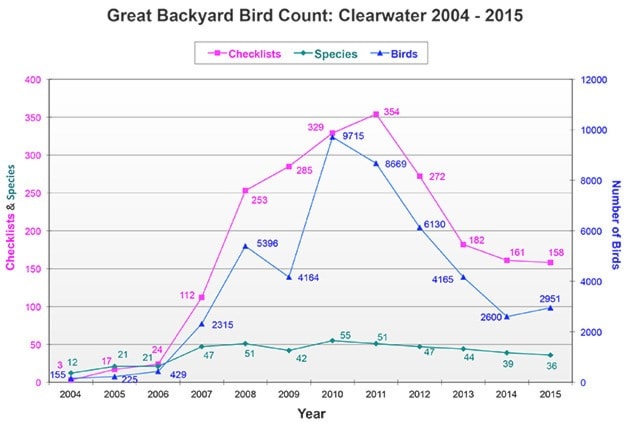As they had difficulty finding any to count, it will be with disbelief that many Great Backyard Bird Count participants will learn the number of individual birds was actually greater this year than last.
As usual, many birds disappeared within a few weeks prior to the GBBC. Some people thought the warmer weather might entice migrants to arrive earlier, but the birds may have been waiting for a welcome push from a southerly wind and also realized the area still had considerable snow.
Though bird numbers were up, the number of species (36) was the lowest since 2006, but that year had only 24 checklists compared to this year’s 158.
With more than 100 countries participating, the community was only beaten for checklist submissions by eight countries: the United States, Canada (of course), India, Australia, Mexico, Costa Rica, Portugal, and New Zealand. Chile, Puerto Rico, and the United Kingdom were ahead of us last year, but slipped behind this year.
The most individual birds this year were Pine Siskin (730); Black-capped Chickadee (717); Common Raven (301); Dark-eyed Junco (153); and Red-breasted Nuthatch (122).
After being in fifth place just two years ago, Evening Grosbeaks continued their major decline the last few years to zero sightings. Similarly, one Pine Grosbeak was spotted after none appeared last year. Red Crossbills followed their usual pattern of not appearing every other year, so this was another year of zero sightings. Chestnut-backed Chickadees were absent for the second year in a row along with Red-winged Blackbirds (one was sighted, but not reported and several more were seen a few days later).
On a more positive note, one Mourning Dove was sighted for the first time since 2009. Firsts since the area’s GBBC started in 2004: the Wilson’s Snipe appeared for the second year in a row; and Common Goldeneye had its highest number (66). After being reported for the first time last year, the number of Eurasian Collared Doves increased from 7 to 28.
The most frequently spotted species was the Black-capped Chickadee (107 checklists) followed by Common Raven (74); Red-breasted Nuthatch (62); Northern Flicker (44); and Downy Woodpecker (37).
Those most individual Pine Siskins mentioned earlier were relegated to eighth place, only appearing on 27 checklists.
Appreciation for promoting the event goes to Home Hardware, RONA, The Times, and especially Clearwater Library for providing blank, local checklists for those who wanted one and creating a display about the event.
Kudos to those who attempted to participate but never saw any birds. Unfortunately, zero species is not accepted by the GBBC. The number of participants for this year would likely have been slightly higher than last year if those people weren’t skunked.
Many thanks to everyone who managed to fit some counts into their busy schedule. Certainly, the GBBC appreciates your effort as a citizen scientist and look forward to your participation Feb. 12 – 15 in 2016.
